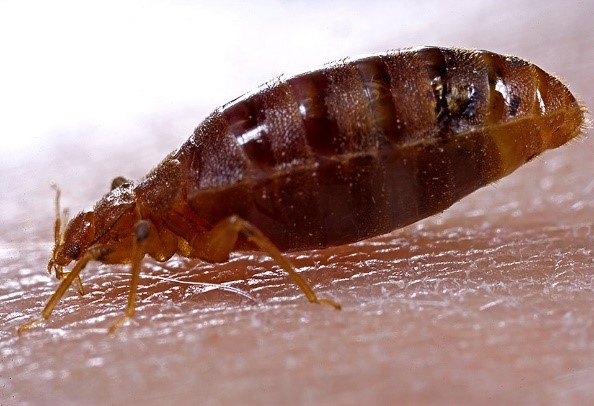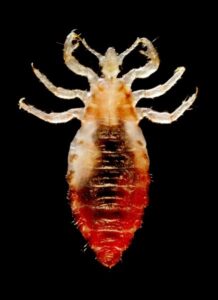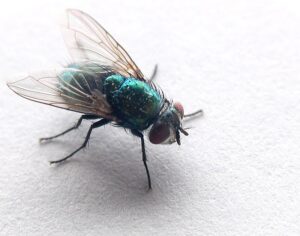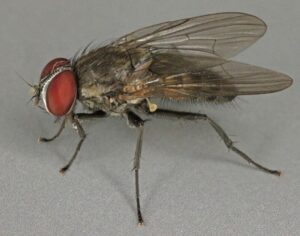Introduction
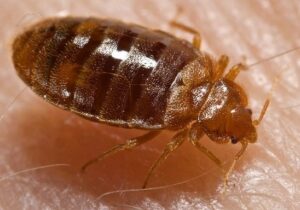
Bed bugs are members of the blood-feeding insect groups and are among the most annoying and widespread medical pests in the world, and they are known as a result of their close contact with human life, as they parasitize mammals, including humans. At present, the control of this insect is a challenge for workers in the field of public health pest control, due to the difficulty in detecting injuries due to its habits of hiding in protected places such as floors, cracks, holes, and sleeping beds.
The family Cimicidae of the order Hemiptera includes two types of bugs, the common bed bug Cimix lectularius and the tropical bug Cimix hemipterus, and the first type is found in most parts of the world. Although it has not yet been proven that bed bugs transmit pathogens between humans or animals, laboratory studies have shown their ability to transmit some diseases.
Why are bed bugs considered a household pest?
- Their presence in the house is regarded as a disgrace to its occupants because they are foul-smelling and shaped creatures associated with a low and filthy standard of living.
- Its pricks cause severe pain, especially for those with sensitive skin, and leave swollen spots around the skin puncture site.
Two bed bug species are found in the UAE and have similar morphological characteristics and life cycles:
- The common bed bug – Cimix lectularius Linnaeus – (Cimicidae: Hemiptera)
- The tropical bug – Cimix hemipterus Fabricus – (Cimicidae: Hemiptera)
General Description
Adult
 |
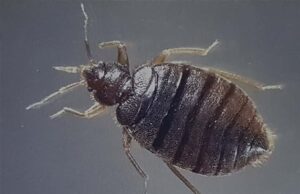 |
|
Cimix lectularius |
Cimix hemipterus – PCS-Dubai |
 • The whole insect is flattened from top to bottom, oval in shape, with a width equal to a length of 4-6 mm, and its body is covered with short hairs.
• The whole insect is flattened from top to bottom, oval in shape, with a width equal to a length of 4-6 mm, and its body is covered with short hairs.
• The general color is light yellow to brown when hungry, and dark red after feeding on a meal of blood.
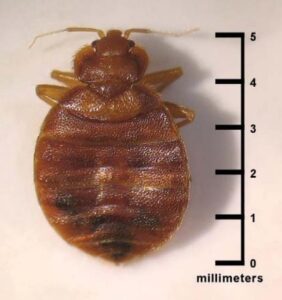
• The front of the head is conical, short and narrow from the front. The mouthparts (proboscis) are a sucking bore in the form of a proboscis that
folds under the head when not in use and extends back between the bases of the forelegs.
• Antenna long consisting of 4 rings.
• The female differs from the male in that her body is more broad and almost spherical in shape.
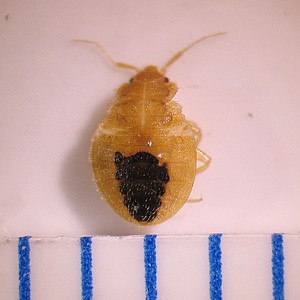
Nymph
• The nymphs are smaller than the whole insect and have a lighter color. It is difficult to notice the nymph of the first age with the naked eye.• The color of the nymphs is pale yellow and turns reddish-brown at the first opportunity to feed on blood.
Life Cycle and Common Characteristics
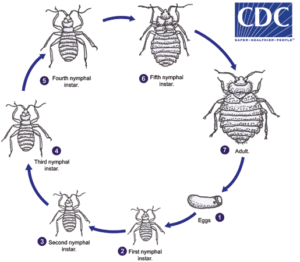
- The life cycle goes through three main stages (eggs, nymphs, adults or adults).
- After mating, females lay eggs in their living quarters in the crevices of walls, behind wallpaper, curtains, picture frames, bed folds, blankets, structures and bed hems to be near the human body.
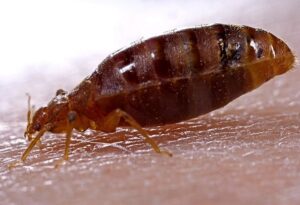
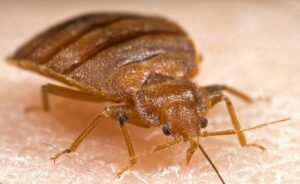
- The female lays 200-500 eggs in blocks, each containing 10-50 eggs, in batches of 2-4 eggs per day in a period of 2-3 months.
- Eggs are pearly white, opaque capsules that are about 1 mm in length.
- Females secrete a glue to stick eggs to surfaces.
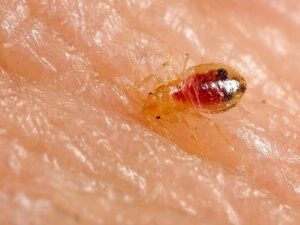
- The eggs hatch after 3-21 days (the average is a week), depending on the temperature, into nymphs. 5 molts occur between each molt, 8 days on average. The nymph must obtain a full meal of blood once between each molt, and the size of the insect increases from 30-40% at each age.
- Nymphs can withstand hunger for up to 5 months, and the whole insect can survive for about a year without food, and this explains the presence of these insects for a long time in uninhabited dwellings.·
- The life cycle takes an average of 32-128 days (may survive for one year, if conditions permit), and it has 3-4 generations per year.
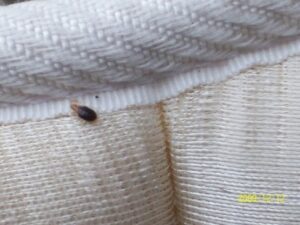
- The different stages of bed bugs are found in many places: under beds, chairs and benches, on mattresses and sheets, seams and tufts of thread and under buttons in mattresses, pajamas, pillows, under rugs and carpets, openings, cracks and holes in floors and walls, folds in curtains, rooms cabinets, around windows and doors, under wallpaper, especially in places that are not well pasted, inside radios and clocks.
- There are insect eggs and the skins of the nymphs and their excrement near their shelter, near the cracks, holes and voids.
- The insect leaves dirty black spots on the bed and walls of its excrement. The high infestation also results in a distinctive foul odor secreted by the insect from its scent glands.
Damage and Medical Implications
- Bed bugs are good vectors for pathogens because:
− It feeds mainly on blood and parasitizes humans and many other hosts.
− It defecates in a place of feeding near the human dwelling, which provides an opportunity for contamination and transmission of diseases through feces.
- The allergic reaction to bites varies significantly between individuals. In rare cases, bites can lead to secondary infections or anaphylaxis. In severe cases, it may cause iron deficiency and a drop in hemoglobin, which leads to a weakening of the body, in addition to the psychological anxiety caused by the injury.
- It is sometimes difficult or confusing for specialists to differentiate between a bed bug bite and a bite from lice, mosquitoes, ticks, and some skin diseases such as chickenpox.
- Diagnosing a bed bug infestation includes communication with the client, as well as a visual inspection. Without a specimen or clear photo and some background information, it could be impossible to identify the problem and source.

- The most common reactions of bed bug bites (for those who do react) appear to be raised, reddish welts, similar to mosquito bites. They can be mildly itchy to large-area rashes or hives.

- It is common to have more than one bite, often 3-4 in rows, so the number of bites does not correspond to the number of bed bugs present.
- Another variation between individuals who react to bed bug bites, is the reaction time between bite and symptom. Some people suffer delayed reactions, where welts appear several days to a week later, and others wake up with bites. This makes it difficult to determine and pinpoint when and where feeding occurred.
- To identify a possible infestation, look for physical signs of bed bugs. This is true for homeowners and housekeeping staff of various hospitality establishments or institutions.
- Early detection of the presence of bed bugs is the key to elimination. Knowing the signs and acting immediately can mean a huge difference in damage, treatment options, cost, and overall difficulty involved with dealing with bed bugs.

